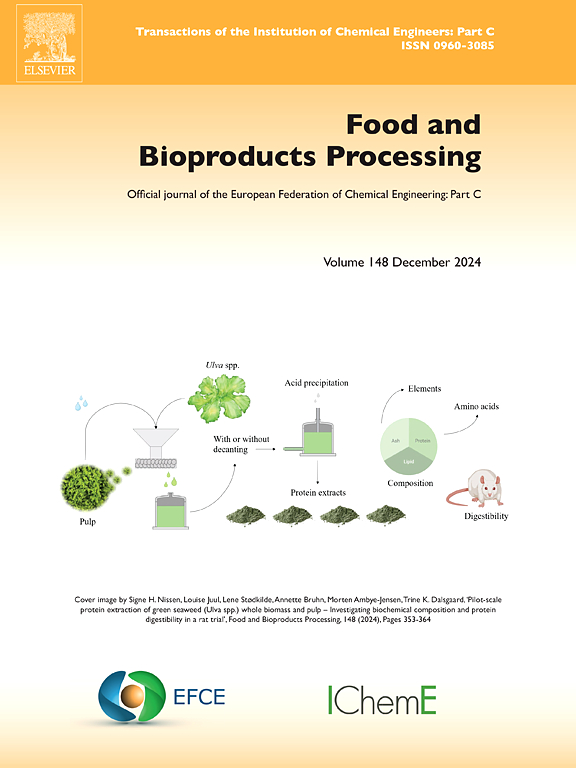Sweet-sour fate of saccharides during sequential processing from apple pomace through acidic extraction and hydrolysis
IF 3.4
2区 农林科学
Q2 BIOTECHNOLOGY & APPLIED MICROBIOLOGY
引用次数: 0
Abstract
Saccharides recovered from apple pomace show great potential to become a precursor for further biochemical processing toward sustainable chemicals. Therefore, the aim of the study was to find a way to maximise the recovery of saccharides from industrially originated apple pomace. Specifically, under investigation was a two-step process, combining tech-scale extraction with acidified water and lab-scale hydrothermal hydrolysis conducted in temperatures between 125 °C and 175 °C, and pH between 2 and 7. The two-step process allowed for 44.9 ± 1.0 wt% recovery of saccharides per initial feedstock, while the one-step processing (only hydrolysis) resulted in 33.6 ± 1.3 wt%. Moreover, the study traced the conversion pathways of saccharides (mono-, oligo, and poly-) through high-performance liquid chromatography (HPLC) and fibre analysis. Results showed that the extraction reduced the severity of furanic compound formation and their re-polymerisation into secondary carbon. Also, it was found that the extraction and hydrolysis of pomace affect its structure and may further introduce a bias to the results of bio-component degradation based on the fibre analysis. In the one-step process, the lignin content was higher than the initial content by 49.4 wt%. It was related to the inclusion of the secondary carbon’s mass into the acid detergent fibre (ADF) mass. The scanning electron microscopy (SEM) analysis confirmed the elevated formation of the secondary carbon through the presence of the spherical shape carbon deposits. The study demonstrated that extraction prior to hydrolysis enhances the overall recovery of monosaccharides (up to ca. 25 wt%). The efficient, two-step recovery of monosaccharides from polysaccharide structures additionally reduced secondary product formation (e.g., 5-HMF) during hydrolysis (by ca. 88 wt%). The proposed processing method should enable the application of the obtained streams of saccharides in further biochemical processing.
苹果渣酸提水解顺序加工过程中糖类的酸甜命运
从苹果渣中回收的糖类显示出巨大的潜力,可以成为进一步生化处理以获得可持续化学品的前体。因此,这项研究的目的是找到一种方法,最大限度地从工业生产的苹果渣中回收糖类。具体来说,我们研究的是一个两步工艺,即在125°C至175°C、pH为2至7的条件下,结合酸化水的技术规模提取和实验室规模的水热水解。两步工艺允许每初始原料的糖回收率为44.9±1.0 wt%,而一步工艺(仅水解)的糖回收率为33.6±1.3 wt%。此外,该研究还通过高效液相色谱(HPLC)和纤维分析追踪了糖(单、寡和多)的转化途径。结果表明,萃取降低了呋喃化合物形成的严重程度,降低了呋喃化合物再聚合成仲碳的程度。此外,还发现渣的提取和水解会影响其结构,并可能进一步引入基于纤维分析的生物成分降解结果的偏差。在一步法中,木质素含量比初始含量高49.4 wt%。这与在酸性洗涤纤维(ADF)质量中含有仲碳有关。扫描电子显微镜(SEM)分析通过球形碳沉积的存在证实了二次碳的形成。研究表明,在水解之前提取提高了单糖的整体回收率(高达约25 wt%)。从多糖结构中有效的两步回收单糖,另外减少了水解过程中二级产物的形成(例如,5-HMF)(约88 wt%)。所提出的处理方法应能使所获得的糖流应用于进一步的生化处理。
本文章由计算机程序翻译,如有差异,请以英文原文为准。
求助全文
约1分钟内获得全文
求助全文
来源期刊

Food and Bioproducts Processing
工程技术-工程:化工
CiteScore
9.70
自引率
4.30%
发文量
115
审稿时长
24 days
期刊介绍:
Official Journal of the European Federation of Chemical Engineering:
Part C
FBP aims to be the principal international journal for publication of high quality, original papers in the branches of engineering and science dedicated to the safe processing of biological products. It is the only journal to exploit the synergy between biotechnology, bioprocessing and food engineering.
Papers showing how research results can be used in engineering design, and accounts of experimental or theoretical research work bringing new perspectives to established principles, highlighting unsolved problems or indicating directions for future research, are particularly welcome. Contributions that deal with new developments in equipment or processes and that can be given quantitative expression are encouraged. The journal is especially interested in papers that extend the boundaries of food and bioproducts processing.
The journal has a strong emphasis on the interface between engineering and food or bioproducts. Papers that are not likely to be published are those:
• Primarily concerned with food formulation
• That use experimental design techniques to obtain response surfaces but gain little insight from them
• That are empirical and ignore established mechanistic models, e.g., empirical drying curves
• That are primarily concerned about sensory evaluation and colour
• Concern the extraction, encapsulation and/or antioxidant activity of a specific biological material without providing insight that could be applied to a similar but different material,
• Containing only chemical analyses of biological materials.
 求助内容:
求助内容: 应助结果提醒方式:
应助结果提醒方式:


